Planet of the Orangutans - Kumai, Kalimantan Province, Borneo Island, Indonesia

Harmonie
Don and Anne Myers
Tue 26 Oct 2010 14:13
|
02:44.038S 111:44.379E
Ok. Now it's time for the really good stuff. Not
that everything else in Indonesia hasn't been good, but how can you beat a trip
up a jungle river to see a bunch of orangutans? Yes, orangutans,
those big, orange, furry beasts who swing through the jungle like Tarzan and
share 95% of their DNA with us humans. As far as animal-in-the-wild
experiences go, we're not sure there is anything cooler.
First things first though...
The 200 mile, two-day, one night motorsail from Bawean Island
to the Kumai River in the Indonesian province of Kalimantan on the big island of
Borneo was mostly uneventful. Uneventful if you don't count a new high
temperature record (93.7F) or the spotting of a new fishing boat species.
This variety has elaborate scaffolding that supports huge lights to attract
squid? (we think it's squid they're after) at night. As opposed to the
flotilla of smaller fishing boats and nets we dealt with during our
previous overnight motorsail, we enjoyed the squid boats because their lights
lit up the horizon for us in the absence of moonlight. Very thoughtful of
them.
We arrived at the mouth of the Kumai River in the early
afternoon of September 30. Our timing was good, although it was just a
happy coincidence and not a result of careful planning on our part, and the
river current was only a knot and half against us as we wound our way ten miles
upstream to the port town of Kumai. We discovered later, during the six
days we were anchored in the river, that the current can run as high as 3.5
knots downstream when the tide is going out - which would have made for an ugly
motorslog upriver had we arrived in the morning and not the afternoon.
Approaching the river mouth, we worried we would have trouble getting over the
shallow bar at the entrance. Then we saw a very large ferry heading toward
us down the river, and figured if they could get over the bar, then we
certainly could. So we did.
Once again the size of the town surprised us. We were
expecting a lazy, laid-back river town with a few local wooden boats and a
broken down dock. What we found was a bustling port town with mid-size
cargo freighters and tankers, tug boats and barges, several wharves for the big
ships and a long line of Sail Indonesia boats anchored along the far side of the
river. We went to the head of the line and dropped anchor, sharing our
part of the river with a very intimidating freighter anchored mid-stream.
We stayed six nights, and over the course of that time, all the anchored boats,
including the tankers and freighters, flipped 180 degrees every six
hours like a choreographed dance with the incoming and outgoing tide.
It wasn't an unpleasant place to be, although we could have done without
the deep brown color of the river water (colored that way due
to silt run-off and effluent coming out of mines in the area),
the mosquitoes, and the oppressive, humid heat. But it's a jungle 160
miles from the equator, so we couldn't really complain.
Borneo is one of the largest islands in the world, and is
split between three countries. Indonesia's Kalimantan Province is the
largest portion, followed by Malaysia's Sarawak Province and the tiny country of
Brunei (which I didn't even know existed until I read about it in the Lonely
Planet). Brunei is like a Muslim Tonga with oil. In other words, one
family basically rules the place, but the country has money because of its oil
reserves.
Now, the orangutans...
We booked a day trip in advance on two small speedboats with
John and Sue and their guests Claire and John (of 'The Man from Snowy River'
fame - blog entry dated 3/22/2010). In addition to the six of
us, there were two drivers and one guide. The plan was to leave around
7:30am and speed up one of the Kumai River tributaries to Tanjung Puting
National Park where Camp Leakey, a working research camp
(think 'Gorillas in the Mist'), is located. We would return around
sunset later that day, and while we were gone, a boat boy would stay in our
cockpit and watch the boats to be sure nothing untoward happened while we
were away.
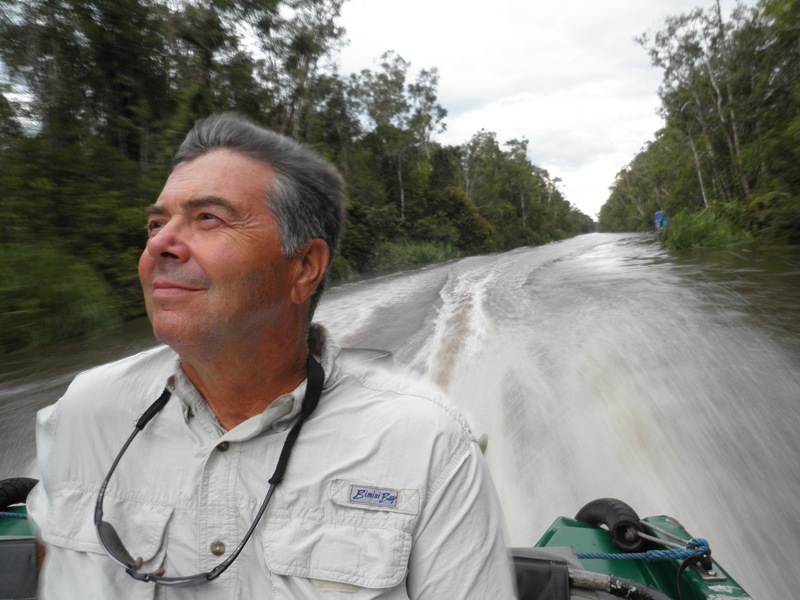 Speeding up the river through the jungle in our
smaller-than-a-Sodus-Bay-ski-boat speedboat. Of course we never have the
opportunity to go this fast in our boat, so we enjoyed the ride. Besides,
mosquitoes can't bite you when you're moving this fast.
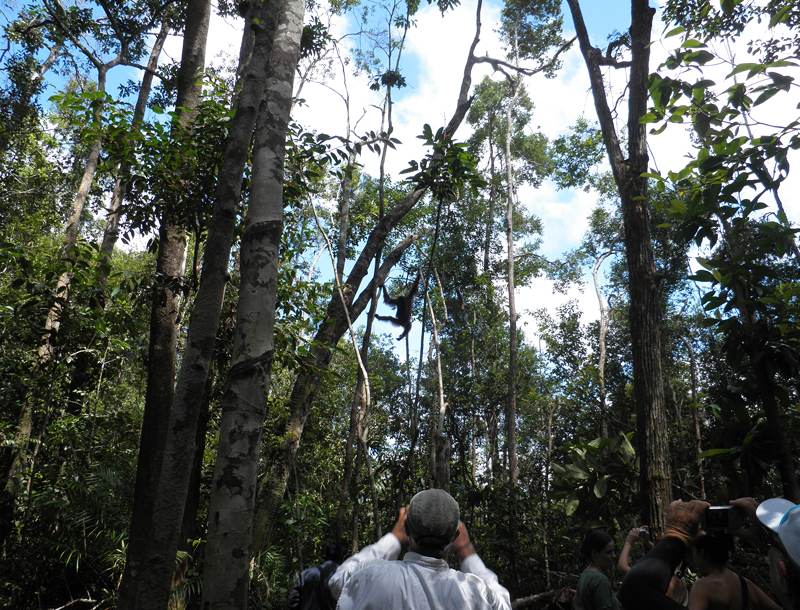 We arrived at the first orangutan feeding station around 9am
after wading through knee-deep water covering flooded boardwalks (the rainy
season has bled into the dry season here, causing lots of flooding),
and walking barefoot along the jungle path. Don commented
several times that it might be hard for people at home to believe we were
walking barefoot through the Borneo jungle - but our feet were wet and we didn't
want to put our socks and sneakers on with wet feet, and besides, our guide
Janie went barefoot the whole day and never ran into a snake or a
leech.
So anyway, the feeding station...
Borneo and the Indonesian island of Sumatra are the only places in the
world outside of Africa where great apes (orangutans are part of the
great ape family) exist. Gorillas, orangutans and chimpanzees are
similar in that they are the three species that have the highest percentage of
DNA in common with humans at about 95%. Also, the three are the only
species that are self-aware, which is what makes them seem so magically (or
eerily depending on your perspective) human-like. The number of orangutans
in Tanjung Puting National Park is something like 7,000. Many of these are
wild and not often seen by tourists like us (although we did see one wild
orangutan in the trees that day). The rest have either been re-introduced
to the wild by the researchers at Camp Leakey, or they are offspring of the
re-introduced orangutans. Re-introduced orangutans come from zoos, or were
once pets, or were orphans cared for by Camp Leakey until they were old enough
to survive on their own in the jungle. The researchers do their best to
encourage the re-introduced orangutans to fend for themselves in the jungle, but
because these lovely creatures are so used to human contact, they often return
to the camp, and frequent the banana feeding stations. As a result, the
researchers and all the guides know all the orangutans that hang out near the
camp by name, and can recite their family history by rote. We found the
bond that exists between the guides and the orangutans to be fascinating as
you'll see later.
We arrived at the feeding station in the middle of the jungle and
found a few Camp Leakey 'banana boys' (young guys that lug the buckets of
bananas and antibiotic-laced sweetened milk to each of three feeding stations
twice daily), and a few other boater tourists, but no orangutans. Our
guide said, "We have to wait for the orangutans. They live a very solitary
existence in the jungle, so have to travel quite a distance through the trees
when they hear the calls from the banana boys at feeding time.
You will hear the orangutans coming before you see them." About ten
minutes later, we heard noise - trees swishing, branches cracking.
Then we could see the trees moving. There was no breeze, not a breath
of air, so it had to be an orangutan causing the commotion. "One is
coming." our guide said quietly. The next five seconds of
anticipation were right up there with that wait before walking down the aisle or
opening that letter from the DMV knowing that this time you passed.
Then she appeared like magic, swinging between the branches of the trees right
in front of us as you can see in the picture above. It was, to use that
overused word, amazing. Positively amazing. Orangutans are the
largest mammals that live in trees, the largest males reaching close
to 300 pounds. So when they swing through the branches, some can't take
the weight and instead of a soft swishing noise, most orangutan movements
are accompanied by a sharp cracking of tree limbs. A stealthy approach is
definitely not their strong suit - but makes for an extremely dramatic
entrance. 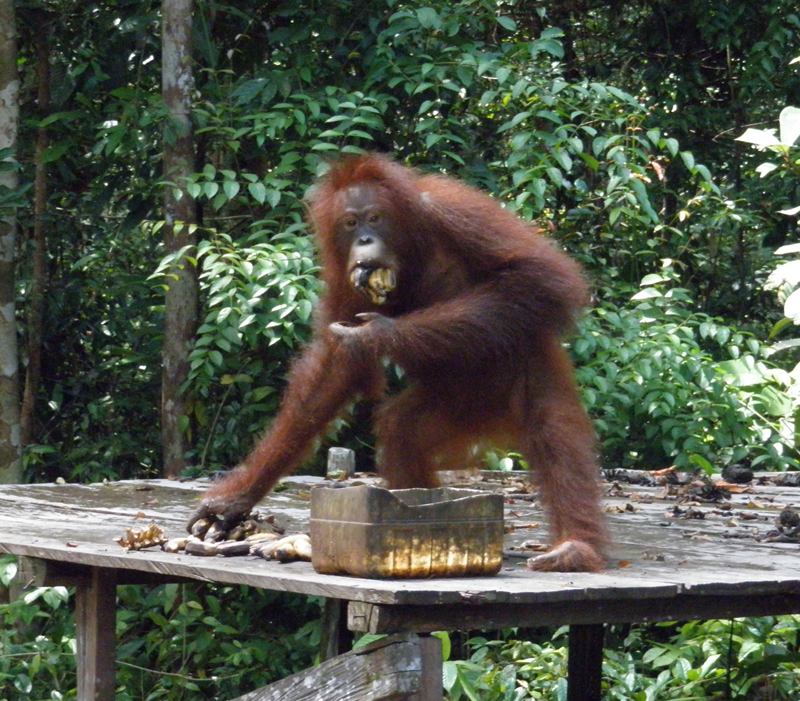 This young guy (can't remember his name, although I'm sure we
were told), climbed down to the feeding platform and proceeded to load as many
bananas as possible into his mouth before climbing back up to a perch in the
trees where he could enjoy his meal in peace (spitting out the banana peels
from above).
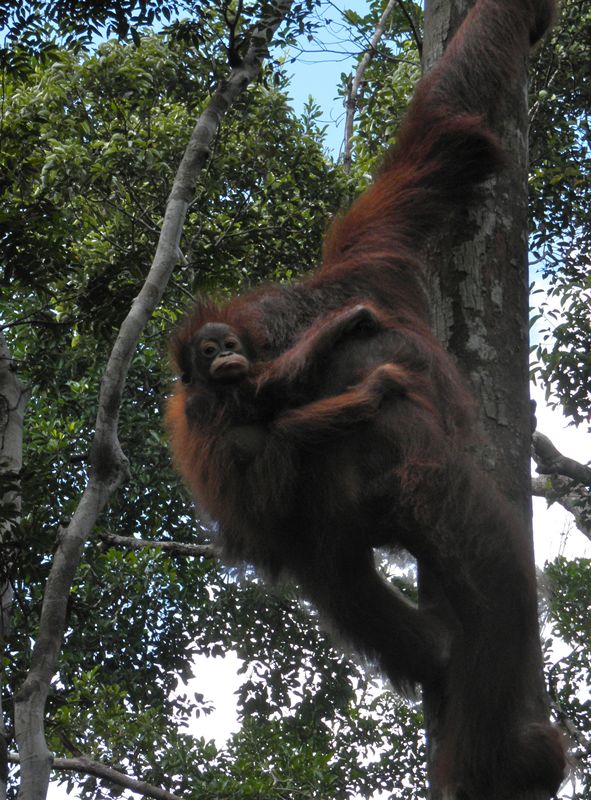 This mom and baby stopped by for a snack. The babies are
adorable and hang on to their mother's backs for 4 to 5 years. Yes, 4 to 5
years. Or until a new baby is born and the older child is encouraged (none
too kindly) by its mother to move on so the new baby can take up residence
on her back. This system works well since it forces the births of
orangutans to a single mom to be spaced apart by 4 or 5 years. Orangutans
need a lot of jungle space to themselves so they can forage for food (fruit,
nuts, termites and other tasty jungle treats). If the population density
gets too high, the orangutans will not be able to find enough food for
themselves. Of course the banana feeding stations help in this regard for
the re-introduced orangutans, but the bananas are not their sole source of food,
so they still need plenty of space to move around. One of the big
problems on Borneo and even in the Tanjung Puting National Park, is illegal
timber harvesting. The Borneo jungle continues to disappear at an alarming
rate, which is a worry for the jungle hungry orangutans.
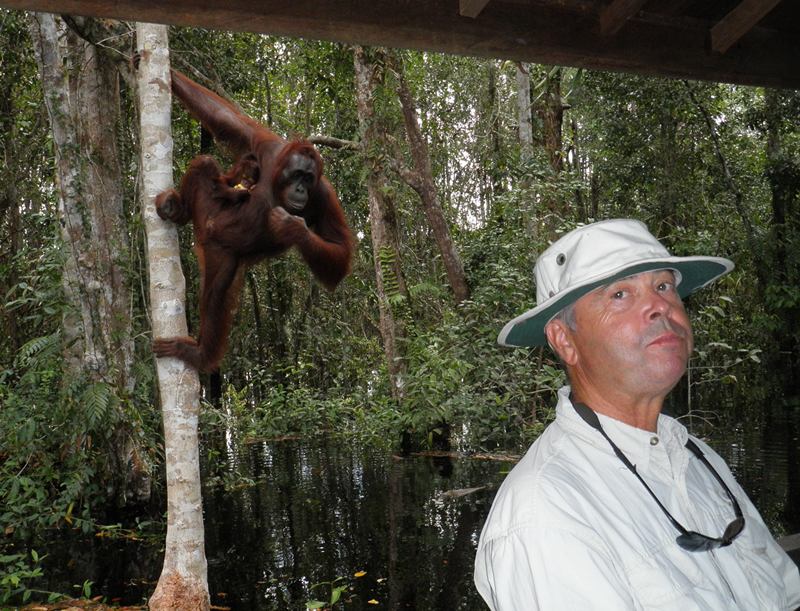 This is not a fake picture! We stopped to have lunch on
the river jetty and this lady and her baby came by to have a peek at Don's
lunch. Our guide gave her a banana (which she promptly gave to her baby as
you can see) to keep her happy and she retreated. I think her name was
Gilda.
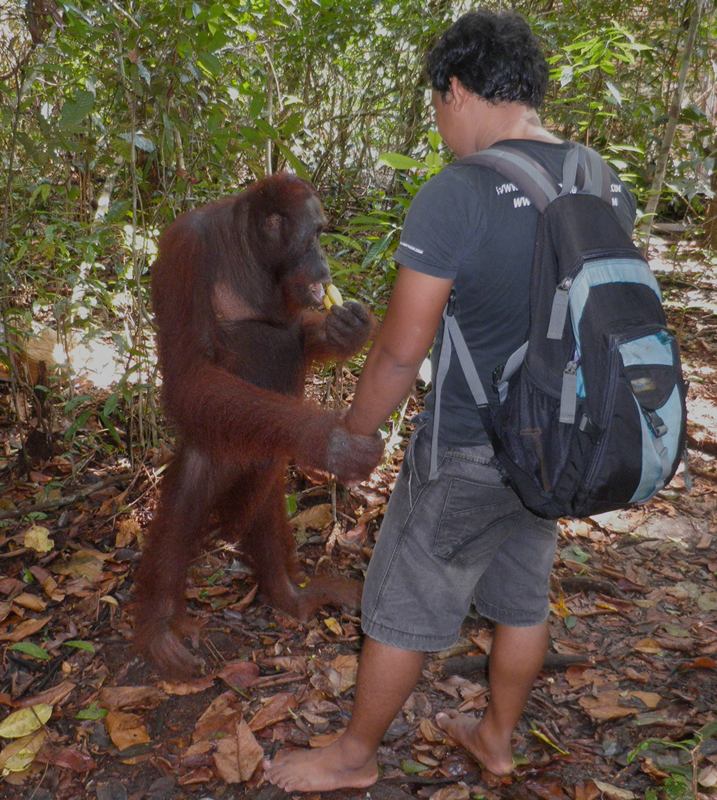 This is our guide Janie and his best orangutan friend,
Pan. Seriously, his best orangutan friend. They've known each other
for years and met when Janie was a lowly cook on one of the tourist river
boats. The story, as Janie told it, goes like this...
Janie was preparing lunch on one of the bigger tourist river
boats tied to the Camp Leakey jetty when he noticed a small male orangutan
trying in vain to get to a small speedboat tied off on the opposite side of the
river. Orangutans can't swim (no mammals in the ape family can swim, but
those in the monkey family can...not sure why), but are resourceful enough to
solve such a problem. The small orangutan, who Janie later learned was
named Pan, climbed into a canoe, untied it from the jetty and paddled himself
over to the speedboat across the river. Once there, he climbed into the
speedboat, letting the canoe float down the river in the process. It's not
clear why Pan was so interested in the speedboat, but it's possible he knew it
contained a cooler full of food. At any rate, Janie noticed that Pan was
having difficulty trying to paddle the speedboat back across the river, so he
stepped in and helped Pan get back. While Janie worked to secure both
the canoe and the speedboat, Pan took it upon himself to eat the entire lunch
Janie had just prepared for the tourists. Fifteen years later and the
two continue to be the best of pals. Janie carries around
pictures of Pan in his wallet and on his cell phone. If Pan had a wallet
or a cell phone, I'm sure he would do the same. We ran into Pan
on the path from Camp Leakey to a feeding station. Janie
introduced us to Pan, spent a few minutes wrestling with him (during which we
could swear Pan was smiling), and gave him a banana snack. A few minutes
later, Pan took Janie by the hand (it definitely was not the other way around as
the picture shows) and Janie explained to us that Pan was asking to go
to the 'banana house' together. They then walked off hand-in-hand in
search of the banana house (Camp Leakey). Janie returned alone a few
minutes later and we went on to the feeding station.
 This guy was enjoying a snack at the feeding station. If
he's not smiling then it's as close to a smile as an orangutan
gets.
 Hanging appropriately near the warning signs at the
feeding station, this is Tom, the dominant male of the re-introduced orangutan
clan. He is huge, with great jowls and cheeks. Only the dominant
male, or those wishing to challenge him have such features. Tom's
cheeks and jowls formed in three months with a surge of testosterone, just
before he challenged the previous dominant male and won. At close range,
he is intimidating to say the least. Below him is a mom and baby on the
feeding platform.
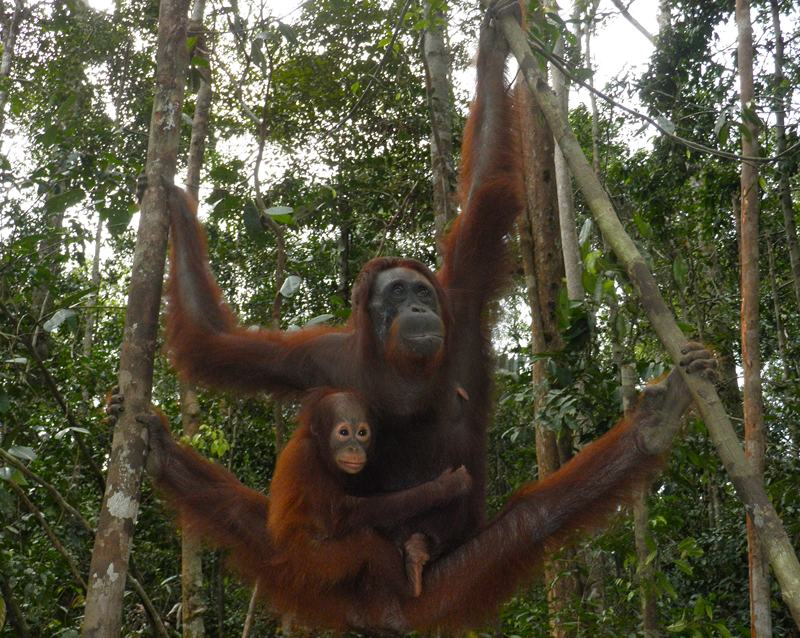 This is my all-time favorite picture. Look at this lady
and her baby. I just can't get over the expressions on their faces and the
way they sit with such ease split between the trees as they are. I'm
gushing, I know, but how can you not love the orangutans??
 There were other things going on in Kumai besides the
orangutans, and we participated in most of them. One day, all the boaters
were loaded onto three full-size tour buses, provided with a police escort, and
toured around the area. We planted trees around a traffic circle as a
gesture of solidarity with the groups doing their best to stem the tide of
jungle destruction via illegal timber harvesting. Then we attended a
cultural festival which didn't seem to have many attendees aside from us.
Strange, we thought, but so were the activities - a form of soccer played in
bare feet with a flaming coconut, targets hung from trees and shot at with blow
guns, and a half-hearted traditional dancing competition between seven groups of
teenagers who looked as though they'd rather be doing something
else. I'm being harsh, but after Bali, everything pales in
comparison. The lunch, however, was a highlight. As usual, it was
provided by the local government (as were the tour buses and police escort), and
later, several of the government officials performed karaoke for us. Where
else in the world would government officials get up and sing karaoke for
tourists? The lovely girls in this picture greeted us at the door of the
restaurant and later danced for us.
 This traditional Dayak longhouse stood next door to the lunch
restaurant. The Dayak people are indigenous to Borneo (as opposed to the
Malaysians and Indonesians who have migrated to Borneo over the
years from Indonesian islands and the Malaysian peninsula) and have a
unique language and culture built around their lifestyle living next
to the rivers in the jungle.
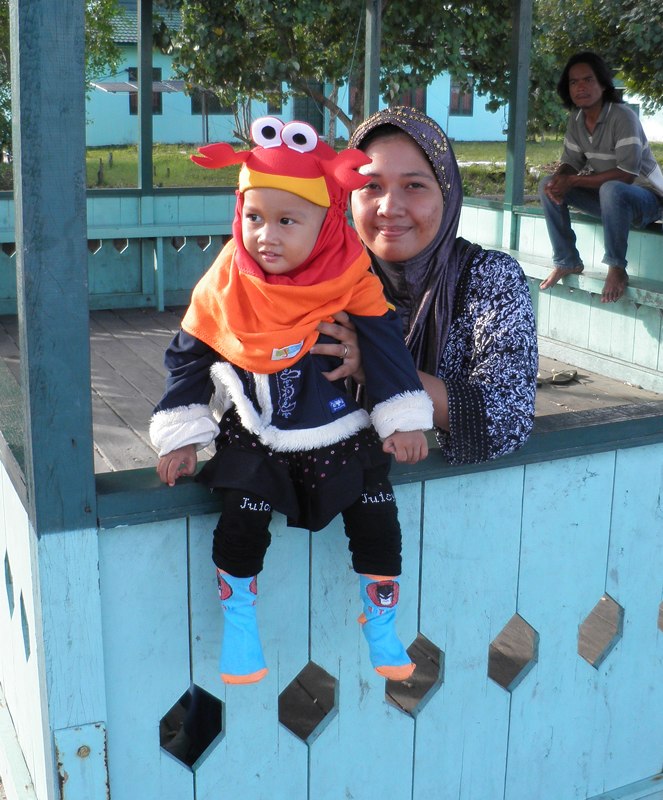 Like most places we've visited, the locals took great interest
in us, our dinghies and our boats. A group was usually waiting on the
dinghy dock to watch us coming and going. This young mom and her daughter
were happy to pose for us on the dock. Kumai was one of the hottest and
most humid places we've visited so far at 90F and 90% regularly. If you
didn't know this, you might think it was a cool 55F based on the way these two
are dressed. And you have to love the daughter's head scarf. No
one can claim the Muslims don't have a good sense of
humor.
At some point during our tour, we learned the number of
tourists to this area number only around 4,000 per year. Only 4,000 people
per year come to see the orangutans! Made us feel pretty
special.
Anne
|